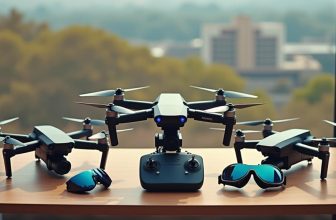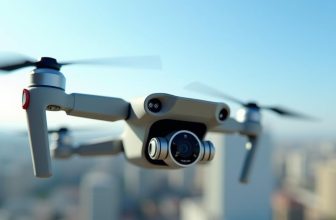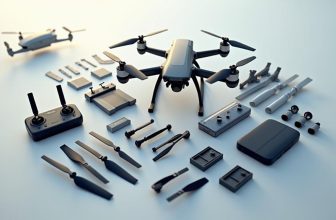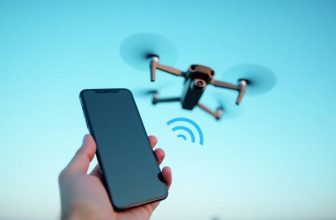
As you consider the versatility of drones, you might wonder how fast they can actually fly. The answer depends on the type of drone and its intended use. While toy drones cruise at a leisurely 10-30 km/h, professional models can reach speeds of up to 80 km/h for tasks like aerial photography. But what about the speed demons of the drone world – racing drones that can break the 100 km/h barrier? You might be surprised to learn that the fastest drone on record reached an astonishing speed, but what’s behind such remarkable velocity, and how high can it go?
Contents
Key Takeaways
- Average drone speed ranges from 20 to 50 km/h (12 to 31 mph), depending on design, weight, and propulsion systems.
- Toy drones typically fly at slower speeds, between 10 to 30 km/h (6 to 19 mph), while professional drones can reach up to 80 km/h (50 mph).
- Racing drones are designed for speed, often reaching speeds up to 100 km/h (62 mph) or more with advanced aerodynamic tweaks.
- The Guinness World Record for the fastest drone was set in 2017, reaching 263.1 mph with extensive flight tests and design optimizations.
- Commercial drone operators must adhere to speed limits set by regulatory bodies, such as the FAA’s maximum speed limit of 87 knots (100 mph) in Class G airspace.
Types of Drones
Drones come in various shapes and sizes, each designed to serve a specific purpose.
As you explore the world of drones, you’ll find that they’re categorized into different types based on their intended use. Drone categories include military, commercial, and recreational drones.
Recreational drones are the most common type and are used for hobbyist purposes.
They’re designed for fun and are often equipped with cameras to capture aerial footage. These drones are usually smaller and lighter, making them easy to maneuver.
Recreational drones can be further divided into subcategories, including ready-to-fly (RTF) drones, which come pre-assembled, and bind-and-fly (BNF) drones, which require a separate radio controller.
It’s essential to understand the different types of drones to determine their capabilities and limitations.
Recreational drones, for example, typically have a lower maximum speed compared to commercial or military drones.
Knowing the drone category will help you set realistic expectations for its performance.
By understanding the different drone categories, you can make an informed decision when choosing a drone that suits your needs.
Familiarizing yourself with drone categories will also help you navigate the complex world of drone technology.
Factors Affecting Drone Speed
When evaluating a drone’s speed, you must consider the interplay of several key factors that impact its performance.
Drone design and weight play significant roles, as a more aerodynamic and lightweight drone can achieve higher speeds than a heavier, bulkier one.
Additionally, environmental air resistance also affects a drone’s speed, as varying air densities and wind conditions can either hinder or enhance its overall velocity.
Drone Design and Weight
A drone’s design and weight substantially impact its speed and overall performance.
When you design a drone, you must consider the aerodynamic shapes that will help reduce air resistance and enable smoother flight. Drones with sleek, streamlined bodies can cut through the air more efficiently, resulting in higher speeds.
You’ll often see drones with curved or tapered shapes, which serve to reduce drag and enhance overall performance.
Another critical factor in a drone’s design is its weight. You want to use lightweight materials that will minimize the drone’s overall weight without compromising its structural integrity.
Materials like carbon fiber, aluminum, and titanium are popular choices for drone construction due to their high strength-to-weight ratio. By using these materials, you can build a drone that’s both robust and lightweight, allowing it to fly faster and more efficiently.
Additionally, a lighter drone will require less power to achieve the same speed as a heavier one, which can lead to longer flight times and improved overall performance.
Environmental Air Resistance
Air resistance, a critical environmental factor, substantially impacts a drone’s speed and overall flight performance.
You’ll notice that air resistance affects your drone’s speed in various ways, depending on the environmental conditions it operates in. When flying in calm air, air resistance is relatively low, allowing your drone to reach its maximum speed.
However, in turbulent air, the situation changes dramatically. Air turbulence creates pockets of air with varying densities, making it difficult for your drone to maintain a steady speed. This turbulence can cause your drone to experience sudden drops or gains in speed, affecting its overall performance.
Wind friction is another key factor that affects your drone’s speed. When flying against the wind, your drone has to work harder to maintain its speed, resulting in reduced performance and increased power consumption.
Conversely, flying with the wind can increase your drone’s speed, but it also requires careful navigation to avoid losing control. As you consider the impact of air resistance on your drone’s speed, you’ll need to factor in these variables to optimize its performance in various environmental conditions.
Average Drone Speed Ranges
You’re likely to find that drones can fly at a wide range of speeds, depending on the type and intended use of the drone.
Generally, the average speed of a drone can vary from 20 to 50 km/h (12 to 31 mph), but these speeds can fluctuate markedly.
This is largely due to drone limitations, such as aerodynamic design, weight, and propulsion systems.
For instance, toy drones tend to fly at slower speeds, typically between 10 to 30 km/h (6 to 19 mph), while professional drones used for aerial photography or surveying may reach speeds up to 80 km/h (50 mph).
Speed variations also arise from the drone’s intended use.
Racing drones, for example, are designed for speed and can reach speeds up to 100 km/h (62 mph) or more.
On the other hand, drones used for precision tasks, such as inspecting or mapping, may fly at slower speeds to maintain accuracy.
It’s vital to weigh these factors when evaluating drone performance and choosing the right drone for your needs.
Understanding the average speed ranges of drones is vital for optimizing their use and effectiveness.
High-Speed Drone Designs
Within the domain of high-performance drones, manufacturers focus on optimizing design elements to maximize speed and agility.
You’ll notice that high-speed drone designs often prioritize aerodynamic tweaks, which play a vital role in reducing air resistance and minimizing drag.
By streamlining the drone’s body and strategically positioning components, manufacturers can create a more efficient airflow around the drone, allowing it to cut through the air with ease.
Propeller optimization is another key factor in achieving high speeds.
By carefully calibrating the propeller’s pitch, diameter, and number of blades, manufacturers can maximize the drone’s thrust-to-weight ratio.
This results in improved acceleration and top-end speed.
Additionally, high-speed drone designs often feature advanced motor systems, such as brushless motors, which provide increased power density and efficiency.
When you combine these design elements, you get a drone that’s capable of reaching incredible speeds.
Drone Racing Speed Records
If you’re looking for the fastest drone racers, you’ll find them competing in events sanctioned by organizations such as the Drone Racing League (DRL) and the International Drone Racing Association (IDRA).
These pilots fly custom-built drones that can reach record-breaking flight speeds of over 100 mph. When it comes to drone racing speed records, you’ll see top speeds that are often achieved by optimizing drone design and configuration for aerodynamics and power.
Fastest Drone Racers
High-speed drone racers, crafted for precision and agility, can reach speeds of over 100 miles per hour.
When you’re watching a drone racing competition, you’re witnessing the culmination of cutting-edge technology and exceptional pilot skills.
The fastest drone racers have mastered the art of charting complex courses, executing intricate maneuvers, and pushing their drones to the limit.
The experience of drone racing is unlike any other, and the rush of adrenaline is palpable.
You can expect:
- Heart-pumping action: Drones zip through gates and tunnels, performing daring stunts and hairpin turns that leave you on the edge of your seat.
- Lightning-fast reflexes: Pilots must have exceptional reaction times to traverse the course and avoid obstacles.
- Mind-bending speed: The fastest drones can reach speeds of over 100 miles per hour, making them a blur as they whizz by.
- Strategic racing tactics: Pilots must employ clever tactics to outmaneuver their opponents and shave precious seconds off their lap times.
- Unparalleled control: The best pilots have mastered the art of drone handling, expertly piloting their drones through even the most challenging sections of the course.
Record-Breaking Flight Speeds
You’ve witnessed the thrill of drone racing, with pilots expertly steering their drones through complex courses at breakneck speeds.
As you watch these aerial acrobats, you can’t help but wonder what the fastest recorded speed is.
The answer lies in the Guinness World Record for the fastest drone, set in 2017. The drone, piloted by Robert Gupta, reached an incredible 263.1 mph.
This achievement was made possible by extensive flight tests and aerodynamic tweaks to the drone’s design.
To achieve such high speeds, drone manufacturers and pilots employ advanced materials and techniques.
They use lightweight yet strong materials, such as carbon fiber, to minimize weight while maintaining structural integrity.
They also optimize propeller design and motor performance to maximize efficiency.
Additionally, they fine-tune the drone’s aerodynamics through computational fluid dynamics (CFD) and wind tunnel testing.
These innovations have pushed the boundaries of drone racing, allowing pilots to achieve record-breaking speeds.
As technology continues to evolve, we can expect even faster drones to take to the skies, further thrilling audiences with their incredible speed and agility.
Commercial Drone Speed Limits
Commercial drone operators must adhere to speed limits set by regulatory bodies, such as the Federal Aviation Administration (FAA) in the US.
These speed limits are put in place to guarantee safe integration of drones into air traffic and prevent potential collisions with manned aircraft. The FAA sets a maximum speed limit of 87 knots (100 mph) for drones operating in Class G airspace, which is the least restrictive type of airspace.
When flying in more restricted airspaces, such as Class B or C, drones are required to operate at slower speeds to minimize the risk of collision with other air traffic.
Failure to comply with these speed limits can result in serious consequences, including fines and loss of certification.
Some of the key concerns related to drone speed limits include:
- Guaranteeing safe separation from other air traffic
- Preventing potential collisions with people or objects on the ground
- Maintaining control of the drone in various weather conditions
- Minimizing the risk of system failure due to excessive speed
- Complying with flight regulations to avoid penalties
Drone Speed Technology Advancements
While adhering to these speed limits is vital for safe drone operation, advancements in technology are continually pushing the boundaries of drone speed capabilities.
As you explore the world of drones, you’ll notice that manufacturers are focusing on battery innovations to increase flight times and speeds. Advances in battery technology have led to more efficient power storage, enabling drones to fly faster and longer.
For instance, high-discharge lithium-polymer batteries are being used to power high-speed drones, allowing them to reach velocities of over 100 mph.
In addition to battery innovations, aerodynamic tweaks are also being implemented to reduce air resistance and increase speed.
Drone designers are using computational fluid dynamics and wind tunnel testing to optimize airframe shapes and minimize drag. These tweaks, combined with lighter materials and more efficient motors, have resulted in drones that can reach incredible speeds.
As you consider the potential of drone technology, key to keep in mind is to stay informed about these advancements and how they’re shaping the industry.
FAQs: How Fast Can a Drone Fly
Can Drones Fly in Extreme Weather Conditions?
When operating drones, you’ll encounter challenges in extreme weather conditions, such as heavy winds that can destabilize flight or icy conditions that can weigh down the drone and reduce its maneuverability.
How Long Do Drones Typically Stay Airborne?
You’re likely wondering how long drones typically stay airborne. Flight duration varies greatly, but most drones have airborne limits ranging from 10-60 minutes, depending on factors like battery type, size, and environmental conditions affecting power consumption.
Can I Fly a Drone Over Private Property?
You must consider property laws and airspace rights before flying a drone over private property. Check local regulations, as some areas restrict drone access, and guarantee you’re not infringing on private airspace or property rights.
Do Drones Require Regular Maintenance Checks?
You’ll be surprised to know 71% of drone crashes are due to maintenance neglect. To avoid this, you’re checking your drone’s battery care every 20 flights and inspecting propellers for damage or wear.
Can I Fly a Drone Near Airports or National Parks?
You must check Airport rules and No fly zones before flying a drone near airports or national parks. FAA regulations restrict drone flights in these areas to guarantee public safety and prevent interference with aircraft.
Conclusion
As you explore the world of drones, it’s clear that speed is a critical factor in their design and application. One fascinating statistic that stands out is that the Guinness World Record for the fastest drone was set in 2017, reaching an astonishing 263.1 mph. This record showcases the incredible advancements in drone technology, pushing the boundaries of speed and performance. With ongoing innovations, it’s exciting to think about what the future holds for drone speed capabilities.






